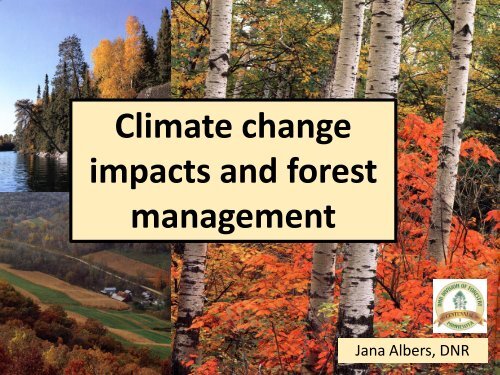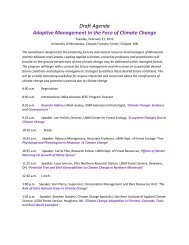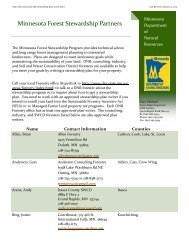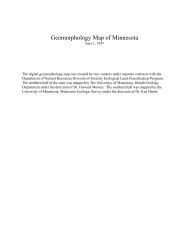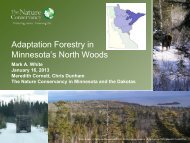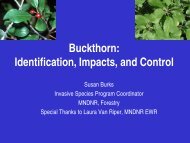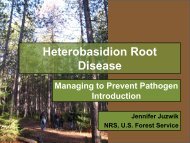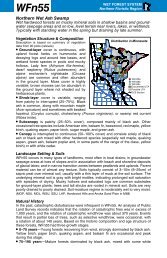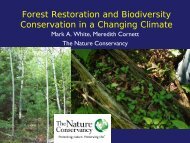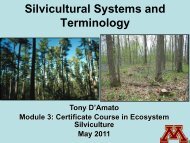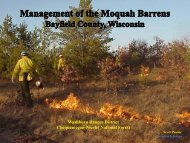Climate change impacts and forest management
Climate change impacts and forest management
Climate change impacts and forest management
Create successful ePaper yourself
Turn your PDF publications into a flip-book with our unique Google optimized e-Paper software.
<strong>Climate</strong> <strong>change</strong><br />
<strong>impacts</strong> <strong>and</strong> <strong>forest</strong><br />
<strong>management</strong><br />
Jana Albers, DNR
<strong>Climate</strong> <strong>change</strong> in the past<br />
Anticipated climate <strong>change</strong>s for Mn<br />
Adding other <strong>forest</strong> health stressors<br />
“Houston, we have a problem.”<br />
Forest <strong>management</strong> adapts
<strong>Climate</strong> <strong>change</strong> in the past<br />
• Four <strong>forest</strong>ed provinces<br />
made up of many types of<br />
<strong>forest</strong> communities at the<br />
present time.<br />
• Forested communities are<br />
literally “living on the edge” of<br />
the prairie.<br />
• The configuration of <strong>forest</strong><br />
<strong>and</strong> prairie/<strong>forest</strong> border was<br />
not always like this.
Evidence of climate <strong>change</strong> in the past<br />
Sequence of major vegetation types in MN from 11,000 years ago to the present.
• Forest communities are<br />
reshaping themselves all<br />
the time.<br />
• Even very “recent”<br />
movements of tree<br />
species show evidence of<br />
a changing climate.<br />
Duration of pine <strong>forest</strong>s in MN<br />
Pollen records show years of<br />
continual occupancy of pine<br />
communities from the present<br />
looking backwards to the last<br />
glaciation.<br />
Almendinger, 2003
Anticipated climate <strong>change</strong>s for Mn<br />
• Increased levels of CO2 <strong>and</strong> O3 in atmosphere.<br />
• Warming temperatures.<br />
In winter, minimum temps will be warmer.<br />
Growing season will be longer.<br />
• Drier weather during the growing season.<br />
• Relative humidity peaks higher in summer.<br />
• More wind storms <strong>and</strong> thunderstorms.<br />
More large-scale blow-down events.<br />
Less percolation of rain water into soil.<br />
Lee Frelich, U Mn
Possible <strong>change</strong>s to growing conditions: 2095<br />
<strong>Climate</strong> projections<br />
for high emission<br />
scenario by 2095.<br />
Union of Concerned Scientists.
Future climate<br />
analogs for Mn<br />
l<strong>and</strong>scapes 50<br />
years into the<br />
future<br />
Galatowitsch, 2009
A schematic depicting the possible dynamics of climate <strong>change</strong><br />
Impacts on<br />
<strong>forest</strong>s<br />
Frelich & Reich, 2009
Tree species maladapted to the future climate will experience<br />
decreases in abundance <strong>and</strong> distribution. Other species will<br />
benefit from climate <strong>change</strong>. Some may be neutral.<br />
The USFS has developed the Tree<br />
Atlas showing where climate<br />
<strong>change</strong> is likely to have effects for<br />
the 130+ tree species in the NE<br />
USA. Based on FIA plots.<br />
In MN, 12 of 22 <strong>forest</strong> species will<br />
have hotspots of <strong>change</strong> where<br />
the tree populations are likely to<br />
diminish. Iverson, 2007<br />
White spruce<br />
Hotspots are hatched polygons.<br />
http://www.nrs.fs.fed.us/atlas/tree/tree_atlas.html
Evidence of tree migration<br />
• Using FIA data, researchers<br />
found that 11 of 15 northern<br />
tree species are moving<br />
northwards, from 20 to 100<br />
km/ century. Woodall, 2009<br />
Fast paced: basswood, s maple, yel<br />
birch, n r oak, bl ash <strong>and</strong> bt aspen<br />
Slow paced: tam, r pine, w pine <strong>and</strong><br />
nw cedar,<br />
Static: balsam fir, bl spruce, w pine,<br />
q aspen BAM <strong>and</strong> p birch<br />
Based on the centers of tree biomass<br />
(red) <strong>and</strong> seedling abundance (blue) for<br />
each tree species.<br />
Tree biomass<br />
Seedling counts<br />
Note: The estimated speed of tree<br />
migration in post-glacial times was<br />
50 km/ century.<br />
Based on comparison of where trees<br />
<strong>and</strong> seedlings at each latitude class.
Implications for tree species<br />
• The prairie/ <strong>forest</strong> border will shift<br />
north <strong>and</strong> east.<br />
• The range of boreal species will shift<br />
northeast.<br />
• Red <strong>and</strong> white pines will hold their<br />
own or do better.<br />
• Northern hardwoods will exp<strong>and</strong>. Red<br />
maple will become very<br />
abundant. Sugar maple <strong>and</strong> red<br />
oaks will increase.<br />
• Birch will rapidly decline; aspen may<br />
slowly decline.<br />
• Central hardwoods will increase but<br />
need connectivity.<br />
Iverson, Frelich, White<br />
Lose acreage:<br />
Quaking aspen<br />
Paper birch<br />
Balsam fir<br />
Black ash<br />
Black spruce<br />
Balm of gilead<br />
Tamarack<br />
Jack pine<br />
White cedar<br />
Mt. maple<br />
Gain acreage:<br />
Bur oak<br />
E. red cedar<br />
Cottonwood<br />
Black walnut<br />
Hackberry<br />
N. red oak<br />
White oak<br />
Honey locust<br />
Silver maple<br />
Boxelder
<strong>Climate</strong> <strong>change</strong> is likely to reinforce the deleterious effects<br />
of other <strong>forest</strong> organisms <strong>and</strong> processes<br />
?<br />
Frelich & Reich, 2009
Effects of deer <strong>and</strong> earthworms will be accelerated by climate <strong>change</strong>.<br />
Deer, with populations 2 to 20 times<br />
higher than historical levels, browse<br />
on herbs <strong>and</strong> tree seedlings.<br />
Currently, they cause the loss of<br />
48-81% of native plant species.<br />
Rooney, 2011<br />
Earthworms consume the duff which<br />
leads to exposed soil, soil<br />
compaction, runoff, droughtier soils,<br />
<strong>change</strong>d nutrient cycles <strong>and</strong> likely<br />
incursion of invasive plants.<br />
Where deer <strong>and</strong> worms occur<br />
together, they cause a major<br />
transformation of the <strong>forest</strong>.<br />
Frelich, 2011
Exotic, invasive plants:<br />
• Their effects will be on a species-by-species basis<br />
affecting biodiversity, shading, nutrient cycling, etc.<br />
• As climate <strong>change</strong> heats up, likely to see:<br />
establishment of more inv plant species,<br />
altered range/distribution of these plants,<br />
altered effectiveness of control strategies.<br />
• Their effects will reinforce warming <strong>impacts</strong>.
Wildfires: <strong>Climate</strong> <strong>change</strong> will likely create<br />
a fire-prone environment with more fuels<br />
<strong>and</strong> more lightning strikes.<br />
• On average, 14% of all st<strong>and</strong>ing<br />
trees are dead (snags). NRS 2008<br />
• With anticipated <strong>impacts</strong> of climate<br />
<strong>change</strong>, the number of snags is likely<br />
to increase, fueling future wildfires.
Blowdown:<br />
• More frequent <strong>and</strong> more serious<br />
storms (derechos) in northern MN<br />
are expected.<br />
• In the last 20 years, we’ve<br />
exceeded a millenium’s worth of<br />
blowdown acres in MN.<br />
Almendinger
Insects <strong>and</strong> pathogens (native <strong>and</strong> exotic):<br />
Even a modest climate <strong>change</strong> will have rapid<br />
<strong>impacts</strong> on the distribution <strong>and</strong> abundance of<br />
many <strong>forest</strong> insects <strong>and</strong> pathogens because of their<br />
short life cycles, mobility, reproductive potential<br />
<strong>and</strong> physiological sensitivity to temperature.<br />
Ayres, 2007<br />
<strong>Climate</strong> <strong>change</strong> could<br />
• Directly affect the development <strong>and</strong> survival<br />
of insects <strong>and</strong> pathogens.<br />
• Alter the abundance of their natural enemies<br />
<strong>and</strong> competitors.<br />
• Alter host tree physiology or defenses.
Examples of <strong>impacts</strong> of climate <strong>change</strong> on insects<br />
• Reduced overwintering mortality from cold weather events.<br />
• Faster development/ more generations per season due to<br />
warmer <strong>and</strong> longer summers.<br />
Ips pine bark beetles could move from<br />
2 generations per year to 3 gens/yr.<br />
in central <strong>and</strong> northern MN.<br />
• Disrupt the phenological synchrony between insects <strong>and</strong> their<br />
natural enemies.<br />
Population increases of larch casebearer are<br />
thought to be caused by warmer temperatures<br />
that favor the defoliator over its parasites.
Examples of <strong>impacts</strong> of climate <strong>change</strong> on insects<br />
Insects <strong>and</strong> pathogens may<br />
move/migrate <strong>and</strong> establish<br />
new ranges as climate<br />
becomes warmer<br />
• As the mountain pine<br />
beetles become<br />
established in boreal<br />
jack pines, they might<br />
move east through<br />
Canada, into<br />
Minnesota.<br />
• 2°C rise allows<br />
expansion about 360<br />
miles north.<br />
Current<br />
locations of<br />
mountain<br />
pine<br />
beetles<br />
Jack pine<br />
Mountain pine beetle
Changed tree physiology <strong>and</strong> defenses:<br />
As trees become stressed by drought, <strong>change</strong>s in tree chemistry<br />
can occur. Certain pests, called “opportunistic pests”, key in on<br />
these stress-related chemicals <strong>and</strong> successfully attack <strong>and</strong> kill the<br />
stressed trees.<br />
Stressed<br />
trees<br />
Energy<br />
depletion<br />
Site, Age,<br />
Defoliation,<br />
Drought,<br />
Wound,<br />
Construction<br />
+<br />
Opportunistic<br />
Phloem miners<br />
pests<br />
Armillaria<br />
Dead trees
Examples of tree species that have opportunistic pests<br />
• Pines, tamarack,<br />
oaks, birches,<br />
aspen, etc.<br />
• Armillaria root<br />
disease can kill<br />
stressed trees.<br />
Red pine<br />
Bark beetles<br />
• Persistent<br />
outbreaks of<br />
opportunists<br />
will be the<br />
bellwethers of<br />
climate <strong>change</strong>.<br />
Northern red oak<br />
Two-lined chestnut borers<br />
http://www.nrs.fs.fed.us/atlas/tree/tree_atlas.html
Multiple agents will reinforce<br />
the impact of global warming<br />
on <strong>forest</strong>s.<br />
• In the short-term, weather<br />
<strong>change</strong>s will allow<br />
opportunistic pests <strong>and</strong><br />
abiotic declines to accelerate<br />
the demise of tree species no<br />
longer suited to their current<br />
sites. They will lose<br />
abundance <strong>and</strong> acreage.<br />
• Other tree species will<br />
migrate into MN or existing<br />
species will become more<br />
prevalent as their range<br />
exp<strong>and</strong>s. They will gain<br />
abundance <strong>and</strong> acreage.<br />
Implications of climate <strong>change</strong><br />
Lose acreage:<br />
Quaking aspen<br />
Paper birch<br />
Balsam fir<br />
Black ash<br />
Black spruce<br />
Balm of gilead<br />
Tamarack<br />
Gain acreage:<br />
Jack pine<br />
Bur oak<br />
White cedar<br />
E. red cedar<br />
Mt. maple<br />
Cottonwood<br />
Black walnut<br />
Hackberry<br />
N. red oak<br />
White oak<br />
Honey locust<br />
Silver maple<br />
Boxelder
“Houston, we have a problem.”<br />
Expectations: Forests are being viewed as essential for climate<br />
<strong>change</strong> mitigation via carbon sequestration <strong>and</strong> biomass production<br />
on a global scale.<br />
Fears: Will there be so many deleterious <strong>change</strong>s to <strong>forest</strong>s in a very<br />
short time that <strong>forest</strong>s cannot sustain themselves?<br />
Human abilities <strong>and</strong> capacities: What about <strong>forest</strong> <strong>management</strong>?<br />
Are old goals <strong>and</strong> schemes irrelevant? How do we “hit” multiple<br />
moving targets involved with climate <strong>change</strong>? When <strong>and</strong> where do<br />
we start?
Forest <strong>management</strong> adapts<br />
• Continue to use existing <strong>and</strong> proven <strong>management</strong> techniques.<br />
These keep our trees <strong>and</strong> native plant communities vigorous,<br />
productive <strong>and</strong> resilient to adverse <strong>change</strong>s.<br />
D’Amato<br />
• Just like the trees in the <strong>forest</strong> adapting to the effects of climate<br />
<strong>change</strong>, <strong>forest</strong>ers must adapt <strong>management</strong> strategies to new <strong>and</strong><br />
anticipated conditions.<br />
<strong>Climate</strong> <strong>change</strong> <strong>and</strong> <strong>forest</strong>s<br />
of the future: Managing in<br />
the face of uncertainty.<br />
Millar, Stephenson <strong>and</strong> Stephens
Adaptation strategies defined<br />
Millar, Frelich, D’Amato, DNR, etc<br />
Resistance = help species/ecosystems<br />
to remain un<strong>change</strong>d in the face of<br />
climate <strong>change</strong>.<br />
Resilience = increase the abilities of<br />
species/ecosystems to absorb or adapt<br />
to effects of climate <strong>change</strong>.<br />
Facilitation = actively manage to help<br />
the ecosystem adapt toward a<br />
predicted direction of climate <strong>change</strong>.
Resistance = defend high-risk or high-value resources<br />
against <strong>change</strong>. “Homel<strong>and</strong> security approach”<br />
• Costly; direct at critically endangered<br />
resources; effective for a short time.<br />
• More effective now rather than later.<br />
• Allows NP Communities to persist until<br />
other adaptations become necessary.<br />
• Prevent or reduce other external <strong>forest</strong><br />
health stressors: deer, invasive pests,<br />
invasive plants, earthworms.<br />
• Limit size of wildfires; create fire breaks.<br />
• Use thinning to control st<strong>and</strong> density so<br />
trees can survive drought.<br />
• Use ERF to buildup stored “carbon”.
Resilience = increase the abilities of species/ ecosystems to<br />
absorb or adapt to effects of climate <strong>change</strong> by<br />
building st<strong>and</strong> <strong>and</strong> ecosystem complexity.<br />
“Health care approach”<br />
• Will work as an interim measure or<br />
where uncertainty is high.<br />
• Increase species diversity.<br />
• Increase age diversity.<br />
• Increase genetic diversity by<br />
planting “southern” seed<br />
sources.<br />
• Move towards uneven-aged mgt. or<br />
multi-age st<strong>and</strong>s.<br />
• Prevent or reduce external stressors.<br />
• Preserve buffers around reserves.<br />
• Build the up the seed bank.<br />
Seed<br />
zones
Facilitation = actively manage to help the ecosystem adapt<br />
towards a predicted direction of climate <strong>change</strong>.<br />
“Humble helper approach”<br />
• We have limited capacity to underst<strong>and</strong> it all.<br />
• Will work for the largest magnitudes of climate<br />
<strong>change</strong>.<br />
• Risky to implement now because we aren’t<br />
sure how climate <strong>change</strong> will actually proceed.<br />
• Establish travel corridors in expected direction<br />
of species <strong>change</strong>/ migration.<br />
• Establish transitional refugia.<br />
• Assisted migration <strong>and</strong> colonization of species<br />
esp. oaks <strong>and</strong> other large-seeded trees.<br />
• Anticipate <strong>and</strong> plan for the risks & losses:<br />
large-scale fires, pest outbreaks, declines, etc.<br />
• Continue to prevent or reduce <strong>impacts</strong> of nonclimate<br />
tree stressors.
Continue to use existing <strong>and</strong> proven <strong>management</strong> techniques.<br />
These keep our trees <strong>and</strong> native plant communities vigorous,<br />
productive <strong>and</strong> resilient to adverse <strong>change</strong>s.<br />
Build in “response diversity”. Manage for high tree species<br />
diversity at the st<strong>and</strong> <strong>and</strong> l<strong>and</strong>scape level so that another species<br />
can fill the vacated niche of species that disappears.<br />
D’Amato<br />
• Build structural complexity:<br />
Promote age class diversity;<br />
at least 2 age classes.<br />
Increase reliance on uneven-aged<br />
<strong>management</strong>.<br />
• Build compositional complexity:<br />
Use new species mixes.<br />
Increase species redundancy by<br />
introducing species over a<br />
wide range of environments.
• Trees <strong>and</strong> their <strong>forest</strong> communities<br />
have survived large-scale tree migration<br />
events in the past <strong>and</strong> <strong>change</strong>s in the<br />
location of the prairie/ <strong>forest</strong> border.<br />
• I believe that new <strong>forest</strong> communities<br />
will emerge along with new disturbance<br />
regimes that will maintain them.
Any questions?
DNR Forest Health Unit<br />
Val Cervenka<br />
FH Coordinator<br />
651 259-5296<br />
Susan Burks<br />
Invasive Spp Coord.<br />
651-259-5251<br />
Jana Albers<br />
NW FH Spec.<br />
218 327-4234<br />
Mike Albers<br />
NE FH Spec.<br />
218 327-4115<br />
Ryan Blaedow<br />
Central FH Spec.<br />
651-259-5821
Feedback on<br />
results of<br />
adaptive<br />
<strong>management</strong><br />
strategies will be<br />
provided by<br />
monitoring.
Examples of maladapted trees experiencing stress from<br />
abiotic factors<br />
• Adverse environmental factors add up to cause vigor<br />
problems.<br />
• No pests involved, at least, initially.<br />
• Trees with existing declines may be that much more<br />
vulnerable to the effects of climate <strong>change</strong>.<br />
Birch decline<br />
Ash decline<br />
Paper birch<br />
Black ash
A. Because most <strong>forest</strong> pests are sensitive<br />
to temperature, even modest warming<br />
could speed up their metabolism<br />
requiring more food,<br />
increasing mobility & distribution,<br />
increasing reproduction.<br />
B. Deer, invasive plants <strong>and</strong> earthworms<br />
cause damage to native flora, soil<br />
structure <strong>and</strong> nutrient cycling. Their<br />
effects by will be accelerated.<br />
C. Trees maladapted to their existing sites<br />
will become more <strong>and</strong> more drought<br />
stressed. Conversely, some species will<br />
benefit, by gaining abundance <strong>and</strong>/or<br />
distribution. Others may be unaffected.


